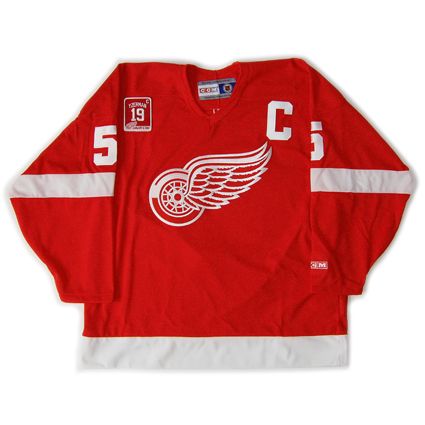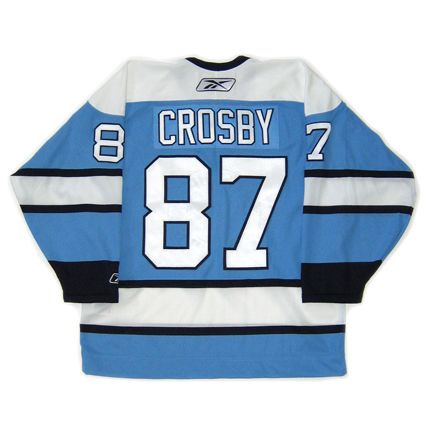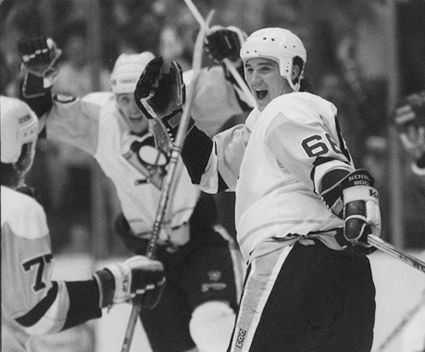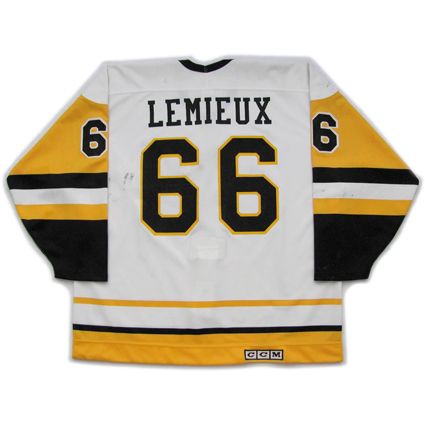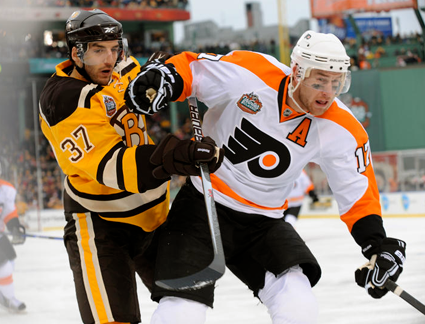
Saturday, January 2, 2010
2010 NHL Winter Classic
Yesterday's 2010 Winter Classic in Boston's Fenway Park between the Boston Bruins and Philadelphia Flyers was a resounding success for the NHL, which featured much better weather than anyone had anticipated based on the forecast for higher temperatures and rain earlier in the week.
It took the Bruins over 57 minutes to score their first goal, but managed to pull off a 2-1 overtime victory on a goal by Marco Sturm in front of a thrilled home crowd in overtime after surviving a couple of excellent chances for the Flyers.
The Flyers jerseys were inspired by their original 1967 jerseys, while the Bruins were wearing a sweater which combined different elements from their past, including their original brown and gold colors worn from 1924-1934, the original style "spoked B" logo first worn on their 25th anniversary in 1949 and a lace up collar, which first appeared on a Bruins jersey in 1967. Overall, the package most closely resembles a 1957 Bruins jersey, which used the same basic gold color and striping pattern and a spoked B logo.

Labels:
Boston Bruins,
Philadelphia Flyers,
Winter Classic
2006-07 Detroit Red Wings Nicklas Lidstrom Jersey
We want to take a moment to welcome readers of the UniWatchBlog today, who are featuring an interview with us today. We invite you to stay awhile and have a look around. After scrolling down through the previous week's entries on this page you will come to our labels links in the right hand column where you can explore any of our previous topics of special interest to you.
We certainly hope you like what you find here at Third String Goalie and take advantage of the opportunity to explore our archives on a wide variety of topics both old and new and the options provided in the right hand column to follow us in the future on twitter, facebook, blogger, yahoo and google or run your name through the Third String Goalie Hockey Name Generator to get yourself ready for the upcoming Olympics.
Thanks for checking us out!
*****************************
On this date in 2007 the Detroit Red Wings retired long-time captain Steve Yzerman's jersey #19.
First up in today's video section, Steve Yzerman's Top 10 goals, including the #1 goal from double overtime of Game 7 of the 1996 playoffs versus the St. Louis Blues.
Yzerman first joined the Red Wings in 1983 after being drafted fourth overall in the 1983 NHL Entry Draft. At the time, the "Dead Wings" were lost in the hockey wilderness, having missed the playoffs 15 of the previous 17 seasons, dating back to the 1966-67 season. After the arrival of Yzerman, the Red Wings qualified for the playoffs in 20 of Yzerman's 22 seasons in the NHL.
His arrival coincided with a change in ownership for the Red Wings, as Mike and Marian Illitch had purchased the franchise in the summer of 1982.
Yzerman scored 39 goals and 87 points in his rookie season, played in his first of 10 NHL All-Star Games and got his first taste of playoff experience as the Red Wings were eliminated by the St. Louis Blues in the first round 3 games to 1.
Prior to the 1986-87 season, Detroit coach Jacques Demers named Yzerman captain of the Red Wings, making him the youngest captain in team history. Yzerman would respond with his third 30 goal season and the Red Wings would reach the third round of the playoffs that season, their deepest run into the playoffs since reaching the finals back in 1966.
His offensive production began to take off during this time period when Yzerman hit the 50 goal mark, as well as topping the 100 points, for the first time in 1987-88. It would be the first of six consecutive seasons with 45 goals or more for Yzerman. The playoffs would see another deep run by the Red Wings, as they once again reached the conference finals for the second year in a row.
The 1988-89 season would see Yzerman reach the pinnacle of his offensive numbers, with 65 goals and 90 assists for 155 points, all career highs and still Red Wings records, as well as being named the winner of the Lester Pearson Award.
The following seasons would see goal totals of 62, 51, 45 and 58 in 1992-93 when he also had 79 assists for 137 points, the second highest season point total of his career. His 65, 62 and 58 goal seasons are the top three in franchise history. Despite the personal success, the Red Wings would fail to advance past the second round of the playoffs from 1989 to 1993.
All that changed with the arrival of new Red Wings coach Scotty Bowman in 1993, who had already won five Stanley Cups with the Montreal Canadiens and one with the Pittsburgh Penguins. He pushed Yzerman to be more responsible defensively and is credited for turning Yzerman into one of the best two-way players in the game, as proven by Yzerman winning the Selke Trophy in 2000.
After trips to both the Finals in 1995 and the Conference Finals in 1996, the Red Wings would capture the Stanley Cup in both 1997 and again emotionally in 1998, their first titles since 1955. Yzerman would be named the winner of the Conn Smythe Trophy following the 1998 playoffs.
The Red Wings would return to the finals again in 2002, defeating the Carolina Hurricanes for the third championship of Yzerman's career.
Three more seasons followed before Yzerman retired following the 2005-06 season with 1514 games played, 692 goals and 1063 assists for 1755 points. In addition, he played in 196 playoff games and is Detroit's all-time leader in goals (70), assists (115) and points (185) and won three Stanley Cups.
Internationally, Yzerman played in the 1983 World Junior Tournament, the 1984 Canada Cup, earning a gold medal, the World Championships in 1985 (silver), 1989 (silver) and 1990 when not busy with the NHL playoffs. He also skated for Canada in the 1996 World Cup of Hockey (silver) and the Olympics in 1998 and 2002, where Canada won the gold medal in Salt Lake City, their first since 1952.
His number #19 was retired by the Canadian National Team in 2005 and on this date by the Detroit Red Wings in 2007, joining Terry Sawchuk, Alex Delvecchio, Ted Lindsay, Sid Abel and Gordie Howe as the only players in Red Wings history with their numbers hanging from the rafters and the first one retired since 1995. During his career Yzerman was also named the winner of the Bill Masterton Trophy in 2003 and the Lester Patrick Award in 2006 and was the longest serving team captain in Red Wings history with 20 seasons of having the "C" adorn his sweater. He was inducted into the Hockey Hall of Fame in 2009.
Today's featured jersey is a 2006-07 Detroit Red Wings Nicklas Lidstrom jersey which features the Steve Yzerman #19 patch worn on the date the Red Wings retired Yzerman's jersey #19. It also has the captain's "C", as Lidstrom was named Red Wings captain beginning with the 2006-07 season following the retirement of Yzerman from the NHL, the first european captain in Red Wings history.
Lidstrom had been on the Red Wings for the previous 11 seasons and was a part of the same three championship teams as Yzerman during that time and was himself the winner of the Conn Smythe Trophy in 2002.
Another classic moment in not only Yzerman's career, but NHL history, as Yzerman presents the 1998 Stanley Cup to Valdimir Konstantinov, seriously injured in a car accident just days after winning the 1997 Stanley Cup.
Here is the actual raising of the banner to the rafters during Yzerman's jersey retirement ceremony. The full ceremony is available on YouTube in eight parts for those of you who wish to view the entire event.
While we could post 100 Yzerman videos, we decided to sum it up with Yzerman's Hall of Fame induction speech from 2009.
Labels:
Detroit Red Wings,
Lidstrom Nicklas,
Yzerman Steve
Friday, January 1, 2010
2007-08 Pittsburgh Penguins Sidney Crosby Winter Classic Jersey
Following the inspiration of the Heritage Classic played when the Edmonton Oilers hosted the Montreal Canadiens, on this day in 2008 the NHL Winter Classic made it's debut with the Buffalo Sabres hosting the Pittsburgh Penguins at Ralph Wilson Stadium, normally home of the Buffalo Bills of the NFL.
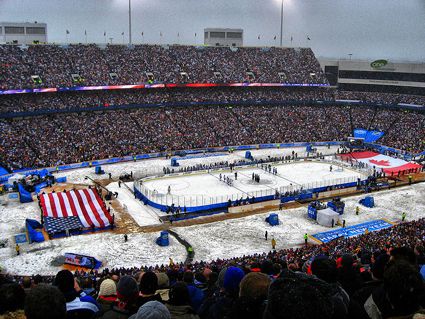
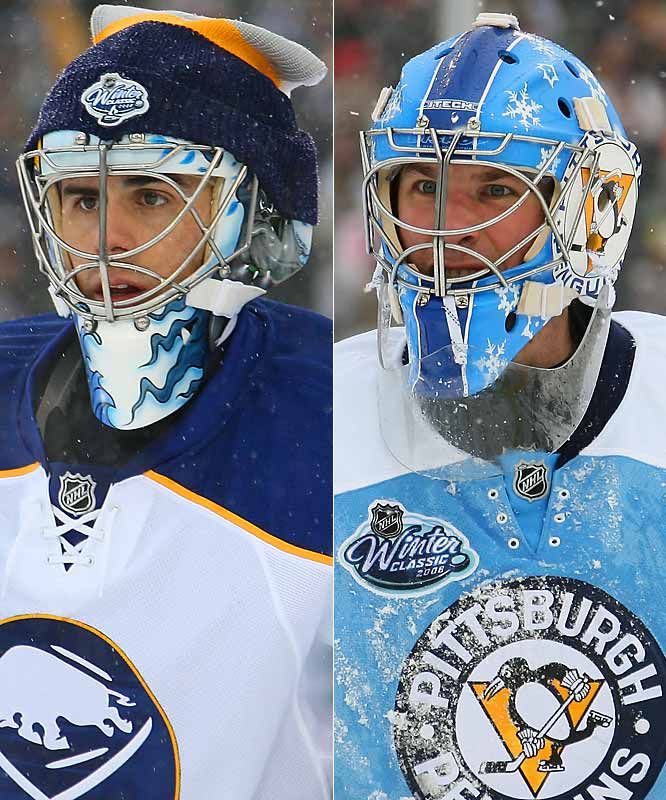
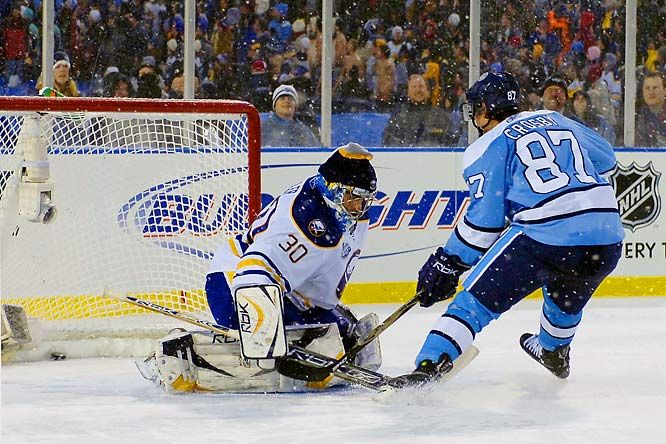

The game was played on a temporary rink built in the center of the football field and was attended by an NHL record 71,217 fans and televised by NBC in the United States and the CBC and RDS in Canada.
The construction of the rink began on December 24th and was completed in plenty of time for the game. One unique rule change instituted for the game required the teams to change ends at the halfway mark of the third period, giving each team and equal amount of time to skate into the wind.
The Penguins wore powder blue throwback jerseys for the first time since 1973, while the Sabres went back to their original look, complete with tie-neck collars. Following the lead of Jose Theodore, who wore a toque during the Heritage Classic, Ryan Miller wore a hockey sock as a stocking cap while tending goal for the Sabres while Ty Conklin, who also played in 2003's Heritage Classic, wore a winter themed mask created specifically for the outdoor event.

Colby Armstrong opened the scoring for the Penguins just 21 seconds into the game with an assist from Sidney Crosby and Brian Campbell replied for Buffalo at 1:25 of the second period to tie the score at 1-1. The third period, played amidst falling snow, was scoreless, as was the resulting overtime period.
The shootout featured goals by Ales Kotalik for Buffalo and Kris Letang for Pittsburgh before the game was won by Crosby for Pittsburgh.

Following the success of the original event, it was staged again in 2009, this time in Chicago's Wrigley Field, when the Chicago Blackhawks hosted the Detroit Red Wings in a game that again featured throwback jerseys and, for the third consecutive time, Ty Conklin in goal, now playing for the Red Wings.
Today's game will take place in Boston, Massachusetts in Fenway Park and will pit the Boston Bruins against the Philadelphia Flyers, neither of which happen to have Conklin on their roster.
The Bruins and Flyers will also be taking advantage of the marketing opportunity and will be wearing retro themed jerseys.
Today's featured jersey is a Reebok 2007-08 Pittsburgh Pengins Sidney Crosby jersey as worn during the 2008 NHLWinter Classic when Crosby scored the game winning goal in a shootout.
Today's featured jersey was based on their 1968-69 design with it's circular crest and single white stripe on the arms and waist, which replaced the previous season's dizzying five stripe design with "PITTSBURGH" diagonally across the front like the New York Rangers.
The Penguins adopted today's featured jersey as their alternate jersey for the following 2008-09 season based on it's immediate popularity when worn in the 2008 NHL Winter Classic.
Here are highlights of the first NHL Winter Classic from January 1, 2008.
Thursday, December 31, 2009
1988-89 Pittsburgh Penguins Mario Lemieux Jersey
In one of the most miraculous nights in NHL history, on this date, New Year's Eve in 1988, Mario Lemeiux of the Pittsburgh Penguins scored five goals - in five different ways!
Their opponents that night were the New Jersey Devils and Lemieux began is night in typical Lemieux fashion, skating down the right side and scoring an even strength goal at 4:17 of the first period to tie the score at 1-1.
His next goal came shorthanded, undressing Aaron Broten and deking Devils goaltender Bob Sauve for a goal at 7:50 with the Penguins a man down.
He was then set up on a power play by Paul Coffey at 9:46 with the Devils two men short, firing a one-timer for the hat trick, all in the first period.
With the Penguins being awarded a penalty shot after the second Devils goaltender of the game, Chris Terreri, threw his stick at the puck while in Lemieux's posession, Lemieux was naturally chosen to take the shot. He converted through Tererri's legs for his fourth of the game at 11:14 of the second, making him three for three in his career penalty shots at the time.
He concluded his magical evening with an empty net goal at 19:59 of the third, giving him five goals in five different ways, something likely to never be repeated any time soon, if ever.
Teammates celebrate Lemieux's spectacular performance
His fifth goal sealed the Penguins victory by a final score of 8-6 as Lemieux completed his eight point night, as he had already assisted on the three goals he didn't score!
Today's featured jersey is a 1988-89 Pittsburgh Penguins Mario Lemieux jersey. as worn on the memorable night during which he scored 8 points on 3 assists and 5 goals, each scored a different way.
This is the first and only year for this particular variation of the Penguins jersey, as the previous season the white sweaters had a gold collar for one season and the numbers were still located up on the shoulders. For 1988-89, the collar changed back to black and the numbers were moved down onto the sleeves, now contained inside the yellow area.
Soon afterwards this style Penguins jersey would undergo it's final changes, with the names on the back now being a sans-serif block font. In addition, the font for the numbers would change slightly, to a thicker font for the back numbers and the sleeve numbers getting noticeably more squarish when compared to the previous style.
Here they are, all five goals in five different ways on New Year's Eve in 1988.
Labels:
Lemieux,
Pittsburgh Penguins
Wednesday, December 30, 2009
1996 Sweden National Team Peter Forsberg Jersey
On this date in 1992, Peter Forsberg of Sweden set a record with 10 points in a single game as Sweden pummeled Japan 20-1 during the 1993 World Junior Championships in Gavle, Sweden.
The format for the tournament that season saw each of the eight teams play the other seven once in a round-robin format, with the top three teams at the completion of the schedule taking home the medals.
Of interest, Czechoslovakia divided into the Czech Republic and Slovakia during the tournament, but the Czechoslovakian team continued to play as one under the title of the Czech and Slovak Republics.
Play began on December 26, 1992 with Canada beating the United States 3-0, Finland downing Czechoslovakia 5-2, Sweden defeating Germany 4-2, and in a hint of what was to come, Russia demolished World Juniors debutants Japan by a score of 16-0.
The following day Japan was again shut out, this time by Finland by a more reasonable score of 7-0, while the host Swedes lost to Canada 5-4.
On December 29, Sweden thumped Czechoslovakia 7-2 and Japan broke their scoreless streak in a 12-2 loss to the United States.
The fateful matchup arrived on this date in 1992, as Sweden faced off against Japan, in a game that ended with a record setting 20-1 score in favor of Sweden. After giving up an average of 12 goals a game up to this point, no one expected much of the Japan-Sweden matchup, but it ended up being the largest victory for Sweden in the history of the tournament, the second most goals ever scored by a team in a game, only 1 behind the record held by Czechoslovakia since 1981.
The game also propelled Forsberg to the record for most points in a game with 10, the most assists by a player in one tournament with 24 and most points by a player in one tournament with 31, most points by a line in one tournament with 69, a mark he shares with Markus Naslund and Niklas Sundstrom, the most all-time assists, with 32, and points in World Junior history with 42.
Naslund also holds the record with 13 goals in one tournament, all thanks in large part to the 20-1 demolition of Japan, who were not surprisingly relegated back to the B Pool for the 1994 tournament after finishing with a 0-7 record with 9 goals for and 83 against. Yes, that is not a typo - eighty-three goals against, following subsequent defeats by the newly re-christened Czech and Slovak Republics on January 1 by a score of 14-2, losing to Canada by a surprisingly reasonable 8-1 and finally losing to Germany 6-3 for the Germans only win of the tournament.
Canada lost on the final day of the tournament 7-4 to the Czech and Slovak Republics, but still earned the gold medal thanks to owning the tie-breaker with Sweden, having defeated them 3-2 in their head-to-head matchup earlier in the tournament.
While Japan was soundly thrashed at the 1993 World Juniors, it was not their worst defeat in international competition. That came in a 25-1 loss to Czechoslovakia at the World Championships in 1957. Don't feel too badly for Japan however, as their greatest triumph occurred in 1999 at the Asian Winter Games when they defeated Kuwait, who making their international debut, by a resounding 44-1.
Forsberg would go on to become a member of the prestigious "Triple Gold Club", having won the World Championships, the Olympics and the Stanley Cup, three titles he has actually won twice each.
Today's featured jersey is a 1996 Sweden National Team Peter Forsberg jersey from the 1996 World Cup of Hockey. Sweden would win the European pool with a 3-0 record, defeating Finland, Germany and the Czech Republic, before losing 3-2 to Canada in two overtimes in the semi-finals.
This jersey features the large 4" diameter 1996 World Cup of Hockey patch worn by all the Bauer supplied teams in the tournament, which also included Canada and the Czech Republic. The remaining teams, the United States, Russia, Slovakia, Finland and Germany all wore Nike jerseys which sported the same patch, only in a 3" size.
Here are the Top 10 rivalry moments between Canada and Sweden in international hockey history, with a memorable appearance by Peter Forsberg.
Next, the fine, fine acting skills of Forsberg are on display for your viewing pleasure.
Labels:
Forsberg Peter,
Sweden,
World Junior Championships
Tuesday, December 29, 2009
1993-94 University of Minnesota Duluth Chris Marinucci Jersey
Born on this date in 1971, Chris Marinucci attended the University of Minnesota Duluth beginning with the 1990-91 season. He started slowly, as most college players do getting used to the size and speed of the college game, with 16 points in 36 games in his first season and 19 in his second.
1992-93 was his breakout season in college, seeing his goal total leap from 6 in each of his first two seasons to 35 as a junior, combined with 42 assists for 77 points, an increase of 58 from the year prior, ranking him second in the WCHA and 8th nationally and helping the Bulldogs win the WCHA regular season title.
1993-94 saw another 30 goals plus 31 assists for 61 points for Marinucci who led the Bulldogs in scoring that season. He was named both the WCHA Most Valuable Player and the 1994 Hobey Baker Award winner, given to the top player in college hockey each season. Throughout his college career, Marinucci played in 149 consecutive games.
Marinucci would turn pro the following season, spent primarily with the Denver Grizzlies of the IHL, scoring 69 points in 74 games. Following the regular season he would add 7 points in 14 games as Denver would sweep the Kansas City Blades for the Turner Cup, awarded to the champions of the IHL each season. Marinucci would also make his NHL debut with the New York Islanders, seeing action in 12 games which included scoring his first and only NHL goal.
He would only see action in eight games due to injuries in 1995-96 with the relocated Utah Grizzlies, forced to move from Denver with the arrival of the Colorado Avalanche. He would see plenty of action with a full season of games in 1996-97, split between one game with the Los Angeles Kings, 21 games with the Grizzlies plus 62 games with the Phoenix Roadrunners, also of the IHL. He would score 52 points in his 62 games in Phoenix. Marinucci would also skate for the United States at the 1997 World Championships, scoring a goal in 8 games.
The next three seasons were spent playing for the Chicago Wolves on the IHL where he would put up fine numbers. 1997-98 was good for 75 points in 78 games and the Wolves would defeat the Detroit Vipers 4 games to 3 to capture his second Turner Cup.
1998-99 followed with career highs with 41 goals and 81 points in 82 games. In addition Marinucci was named the IHL Man of the Year. Another 31 goals and 64 points followed in 1999-00 along with another Turner Cup by defeating the Grand Rapids Griffins 4-2 in the finals before Marinucci would begin racking up the frequent flyer miles.
His first stop on his world tour was Kokudo of the Japan League. Marinucci would score 29 goals and 59 points in 40 games as the Rabbits would capture the championship.
2001-02 saw a move to the Berlin Polar Bears of the German DEL with 36 points in 53 games while 2002-03 was split between the Idaho Steelheads of the WCHL and IF Björklöven of the second division in Sweden.
His career would wind down in 2003-04 with more games in Idaho as well as with the Storhamar Dragons of the Norwegian Elite League, which included 17 regular season games and 13 playoff games en route to yet another championship for Marinucci and a nice way to conclude one's career.
While his number of NHL games were limited, he did play in 405 games in the IHL, scoring 157 goals and 365 points and a trio of Turner Cup Championships as well as titles in Japan and Norway.
Today's featured jersey is a 1993-94 University of Minnesota Duluth Bulldogs Chris Marinucci jersey. This beautiful jersey holds the record for the longest project from start to finish in the history of the Third String Goalie Collection, as we originally purchased the shoulder patches for this jersey back in 1987.
Only recently were we able to complete the project after 22 years now that this jersey has been made available by VintageMinnesotaHockey.com topped off perfectly by our pair of skating Bulldog patches purchased at a game in Duluth all those many years ago with the hopes of some day being able to have this classic looking jersey reproduced.
Will the wonders of YouTube never cease? Of all the unexpected things we've ever found this one probably tops them all - an interview with a newly arrived Marinucci prior to his first game with IF Björklöven in Sweden.
We are literally dumbstruck.
So, how did the big game against those bastards from Skellefteå turn out? Seems like the good guys won, but if you watch this video you will get see a hot babe and some sausages. Promise.
Speaking of Björk loving, when was the last time you saw anyone play a table full of wine glasses? Now that is seriously unplugged.
Monday, December 28, 2009
1984 Team Canada Ray Bourque Jersey
Born on this date in 1960, Ray Bourque played 21 seasons in the NHL and currently holds the records for most goals, assists and points by a defenseman in league history.
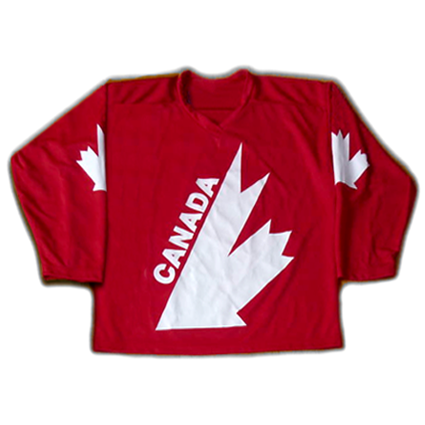
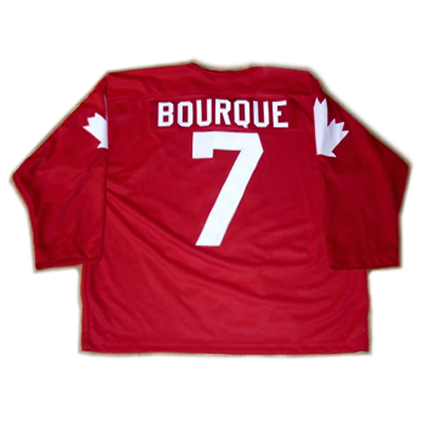
He won the Norris Trophy five times and capped off his career by winning the Stanley Cup in the final game he ever played. His jersey #77 has been retired by both his long time club the Boston Bruins, as well as the Colorado Avalanche, with whom he won the Stanley Cup.
With the World Junior Tournament now taking place, we thought it would be appropriate to take a look back at the international career of Bourque.
He first appeared for Team Canada in the 1981 Canada Cup as a 20-year-old after only two seasons in the NHL and took home a silver medal while contributing 1 goal and 4 assists in 7 games while wearing sweater #8.
He also skated in the 1984 Canada Cup, scoring 4 assists in 8 games. Canada emerged victorious after defeating the Soviet Union 3-2 in overtime before capturing the title by defeating Sweden in the best of three finals 2-0 by scores of 5-2 and 6-5.
Bourque was a member of the NHL All-Star squad that took on the Soviet Union in Rendez-vous '87, a two game series that took the place of the usual NHL All-Star Game that year and scored a goal in Game 2.
His final Canada Cup appearance was in 1987 and was an assistant captain of the squad and again wore #7. Canada defeated Czechoslovakia 5-3 in the semi-finals and won a thrilling best of three final over the Soviet Union after losing Game 1 in overtime 6-5. Canada avoided elimination by taking the Soviets by an identical 6-5 score, only this time in two overtimes. The final game was a nail-biter, with Canada winning by yet another 6-5 score on a goal with just 1:26 remaining in the game. Bourque would finish the tournament with 2 goals and 6 assists for 8 points in 9 games played, good for sixth overall and first among defensemen.
The 1998 Winter Olympics in Nagano, Japan was Bourque's final tournament for Team Canada, where he contributed 1 goal and 2 assists in 6 games.
Today's featured jersey is a 1984 Team Canada Ray Bourque jersey. This jersey is remarkable in it's stark simplicity, with it's one color crest, lacking even sleeve numbers.
Bourque wore #8 during the 1981 tournament and the "A" as assistant captain in 1987 In addition, all players wore Labatt Canada Cup patches on their right chest during the 1987 and 1991 tournaments, making this configuration of Team Canada Bourque jersey unique to the 1984 tournament.
This basic jersey style was used by Canada in all the Canada Cups, starting in 1976 through the final one in 1991, with it's main crest mimicking the Canada Cup trophy, which was not really a "cup" in the proper sense.


Here are the goals from the dramatic final game of the 1987 Canada Cup. Careful viewing will confirm #7 Bourque playing in the game on a couple of occasions. Don't be fooled by #77 Paul Coffey.
Labels:
Bourque Ray,
Canada
Sunday, December 27, 2009
1995-96 Colorado Avalanche Joe Sakic Jersey
On this date in 1999, Joe Sakic of the Colorado Avalanche scored his 1,oooth career point with an assist in a 5-1 win over the St. Louis Blues in Colorado.
Sakic was originally drafted by the Avalanche franchise when they were still the Quebec Nordiques 15th overall in the 1987 NHL Entry Draft.
A little known fact is that Sakic's parents were Croatian immigrants and he grew up speaking Croatian before attending elementary school. He would be named Rookie of the Year in the Western Hockey League of Canadian Juniors in 1987 after scoring 133 points. He also survived a horrific bus crash involving his club, the Swift Current Broncos, in which four of his teammates were killed. The following year Sakic was named WHL Most Valuable Player and Canadian Major Junior Player of the Year after scoring 160 points.
He scored an assist on his NHL debut on October 6, 1988 versus the Hartford Whalers and originally wore sweater #88 because Alain Cote was wearing his preferred #19. He finished with 62 points in 70 games although the Nordiques finished in last place overall in the NHL, which allowed the to select Swede Mats Sundin first overall.
With Cote now retired, Sakic claimed his #19 for 1989-90 and scored 102 points but the Nordiques sank to the depths of the NHL, finishing a distant last in points, 33 points behind the second worst club, with Owen Nolan being the prize that awaited them at the 1990 draft.
1990-91 saw Sakic score 109 points, sixth overall in the league, and be named co-captain of the Nordiques (for home games). Yet another last place finish by the Nordiques, this time by 11 points, put them in position to draft Eric Lindros, despite Lindros' adamant refusal to play for the Nordiques.
Sakic would miss 11 games in 1991-92, which would hurt him in his chances to repeat another 100 point season, and he would conclude the year with 94 points. The Nordiques managed to finish next to last in the standings. Unfortunately, they did not pass any clubs ahead of them from the season before, but "moved up" from last by finishing ahead of the expansion San Jose Sharks in their debut season. While first round draft pick Todd Warriner would never skate for Quebec, being involved in a later trade along with Sundin that would bring in Wendel Clark and Sylvain Lefebvre, the off-season trade of the holdout Lindros for a king's ransom would send the Nordiques on the path to competitiveness, as they would receive goaltender Ron Hextall, Steve Duchesne, Kerry Huffman, Mike Ricci, Chris Simon, future star Peter Forsberg, a pair of first round draft picks in 1993 and 1994 along with a cool $15 million.
Now named full time team Captain of the newly reconfigured Nordiques, Sakic would respond in 1992-93 with 105 points and lead the Nordiques out of the wilderness and into the playoffs for the first time in his career on the heels of a staggering 52 point improvement, double their total of the year prior. Without any previous playoff experience, the Nordiques would be eliminated in the first round by arch-rivals the Montreal Canadiens. The process of building the Nordiques took another step forward by picking both goalie Jocelyn Thibault and Adam Deadmarsh in the first round of the draft.
1993-94 was a slight step back for Sakic, as he would fall short of the 100 point barrier with 92, but the Nordiques would take a large step back, dropping 28 points in the standings and miss the playoffs yet again.
The Nordiques final season of in Quebec saw Sakic finish fourth in scoring during the lockout shortened 1994-95 season and the Nordiques would capture the division title, only to be eliminated in six games by the New York Rangers, ending their time in Canada.
Relocated to Denver, the Colorado Avalanche took to the ice in the 1995-96 season hoping to continue the improvement shown during Sakic's seven seasons in Quebec. Little did anyone anticipate the events that would unfold that season.
After having a major falling out with the Montreal Canadiens, superstar goaltender Patrick Roy was traded to the Canadiens former arch-rivals, now located in Colorado, a trade which would have never, ever happened had the club remained in Quebec. In addition to receiving Roy, veteran Mike Keane would arrive in exchange for Thibault, Martin Rucinsky and Andrei Kovalenko, and the Avalanche were on their way.
Sakic topped 50 goals for the first time with 51, adding 69 assists for a career high 120 points for third in the league. The Avalanche would storm the playoffs, defeating first the Vancouver Canucks, followed by the Chicago Blackhawks by identical 4 games to 2 margins. Next up was a hard fought series with the Detroit Red Wings, upsetting the team that finished 27 points ahead of them in the standings 4-2 for the right to face the upstart Florida Panthers, whom they easily dismissed in four straight games for the the franchises first Stanley Cup Championship in their first season out of Quebec. Sakic would lead the playoffs in scoring that season and be named the winner of the Conn Smythe Trophy.
It had been a long journey for Sakic, who, along with Curtis Leschyshyn, were the only two Nordiques players from the 1988-89 season to suffer through the years of last place finishes to eventually raise the Stanley Cup.
Sakic would eventually play 13 seasons in Colorado, scoring 100 points twice more in his career, eventually hitting the 1,000 point mark on this date in 1999. The Avalanche were regular fixtures in the playoffs, and contenders for the Stanley Cup for seven straight seasons, reaching the conference finals in six of those seven seasons, including winning the Stanley Cup again in 2001.
Today's featured jersey is a Starter 1995-96 Colorado Avalanche Joe Sakic jersey and features the 1996 Stanley Cup Finals patch. This jersey stands apart with it's "mountain range" striping on the waist and arms, unlike any other jersey of it's day. Combined with it's unique color palette, custom number font, memorable secondary shoulder logos and the club's success on the ice, this style Colorado Avalanche jersey is a true icon of it's era and only the change to the templated Reebok Edge jerseys killed off what would have likely been one of those jerseys that lived on unchanged for years.
The white names and numbers on this jersey have a textured herringbone pattern pattern to them, which is called "Glacier Twill". In addition to that detail, the silver outline around all the numbers is a metallic silver material, which is often done as a flat grey material on Avalanche jerseys. The lettering for the name is also tall and narrow, as shown by the shape of the "C", which is also often found as a nearly perfect circle shape with rounded, instead of flat sides like shown here.
Our featured video today are the Top 10 Joe Sakic Moments from his throughout his career.
Labels:
Colorado Avalanche,
Quebec Nordiques,
Sakic
Subscribe to:
Comments (Atom)

